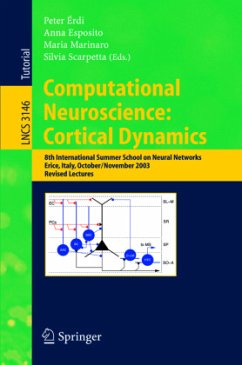
Maximum a Posteriori Models for Cortical Modeling
Feature Detectors, Topography and Modularity
Versandkostenfrei!
Versandfertig in 6-10 Tagen
32,99 €
inkl. MwSt.

PAYBACK Punkte
16 °P sammeln!
This thesis shows in a top-down modeling approach that unsupervised learning rules of neural networks can account for the development of cortical neural connections.Sections 1, Introduction, and 2, The Cortex, comprise biological foundations about the cortex: its areas and their mutual connectivity, cell layers and the mechanisms which govern the development of neural connections. These data supply the goal of modeling as well as the motivation for the methods which are used. Sections 3, Theory, and 4, Models, describe the theory and how to derive models from it. Section 5 presents Results, an...
This thesis shows in a top-down modeling approach that unsupervised learning rules of neural networks can account for the development of cortical neural connections.
Sections 1, Introduction, and 2, The Cortex, comprise biological foundations about the cortex: its areas and their mutual connectivity, cell layers and the mechanisms which govern the development of neural connections. These data supply the goal of modeling as well as the motivation for the methods which are used. Sections 3, Theory, and 4, Models, describe the theory and how to derive models from it. Section 5 presents Results, and section 6, a Discussion.
In this work it is demonstrated that using a sparsely coded Boltzmann machine, neurons emerge which have localized and orientation selective receptive fields like those observed in primary visual cortex. Another highlight is the demonstration of a high adaptability of model structures to the environment. Either parallelly or hierarchically organized modules will arise as an appropriate adaptation to the organization of the training data set.
Sections 1, Introduction, and 2, The Cortex, comprise biological foundations about the cortex: its areas and their mutual connectivity, cell layers and the mechanisms which govern the development of neural connections. These data supply the goal of modeling as well as the motivation for the methods which are used. Sections 3, Theory, and 4, Models, describe the theory and how to derive models from it. Section 5 presents Results, and section 6, a Discussion.
In this work it is demonstrated that using a sparsely coded Boltzmann machine, neurons emerge which have localized and orientation selective receptive fields like those observed in primary visual cortex. Another highlight is the demonstration of a high adaptability of model structures to the environment. Either parallelly or hierarchically organized modules will arise as an appropriate adaptation to the organization of the training data set.












